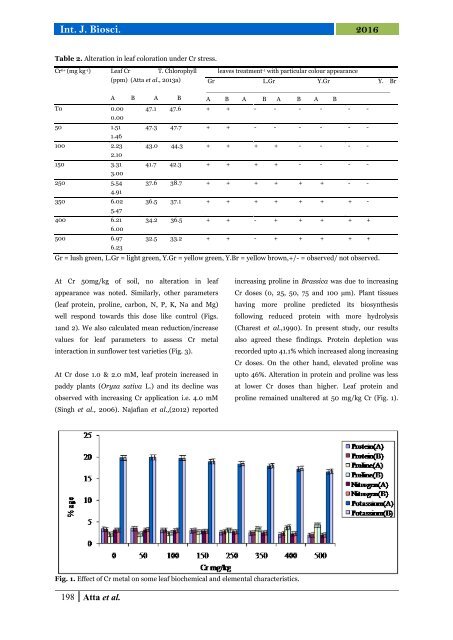Understanding leaf biochemical traits for Sunflower (Helianthus annuus L.) cultivars grown in chromium stressed environment
Abstract Environmental pollution is big curse for plants, animals and other living organisms. Being atmospheric pollutant, different levels of Cr6+ (50-500mg/kg) were applied to sunflower plants to determine its toxic effects. It was found that there was imbalanced distribution of leaf nutrients. XRF studies for various elements revealed alteration in leaf appearance due to nutritional deficiency. Leaf protein was reduced and proline increased pretentiously (p≤0.05) along Cr concentration. Viability of Cr enriched plants strongly showed the environmental protective role of proline. Present study mainly expresses chromium metal toxicity for carbon and nitrogen metabolism predicting poor growth, biomass and yield attributes in Cr treated plants.
Abstract
Environmental pollution is big curse for plants, animals and other living organisms. Being atmospheric pollutant, different levels of Cr6+ (50-500mg/kg) were applied to sunflower plants to determine its toxic effects. It was found that there was imbalanced distribution of leaf nutrients. XRF studies for various elements revealed alteration in leaf appearance due to nutritional deficiency. Leaf protein was reduced and proline increased pretentiously (p≤0.05) along Cr concentration. Viability of Cr enriched plants strongly showed the environmental protective role of proline. Present study mainly expresses chromium metal toxicity for carbon and nitrogen metabolism predicting poor growth, biomass and yield attributes in Cr treated plants.
Create successful ePaper yourself
Turn your PDF publications into a flip-book with our unique Google optimized e-Paper software.
Int. J. Biosci. 2016<br />
Table 2. Alteration <strong>in</strong> <strong>leaf</strong> coloration under Cr stress.<br />
Cr 6+ (mg kg -1 ) Leaf Cr T. Chlorophyll leaves treatment -1 with particular colour appearance<br />
(ppm) (Atta et al., 2013a) Gr L.Gr Y.Gr Y. Br<br />
_______________________________________________<br />
A B A B A B A B A B A B<br />
T0 0.00 47.1 47.6 + + - - - - - -<br />
0.00<br />
50 1.51 47.3 47.7 + + - - - - - -<br />
1.46<br />
100 2.23 43.0 44.3 + + + + - - - -<br />
2.10<br />
150 3.31 41.7 42.3 + + + + - - - -<br />
3.00<br />
250 5.54 37.6 38.7 + + + + + + - -<br />
4.91<br />
350 6.02 36.5 37.1 + + + + + + + -<br />
5.47<br />
400 6.21 34.2 36.5 + + - + + + + +<br />
6.00<br />
500 6.97 32.5 33.2 + + - + + + + +<br />
6.23<br />
Gr = lush green, L.Gr = light green, Y.Gr = yellow green, Y.Br = yellow brown,+/- = observed/ not observed.<br />
At Cr 50mg/kg of soil, no alteration <strong>in</strong> <strong>leaf</strong><br />
appearance was noted. Similarly, other parameters<br />
(<strong>leaf</strong> prote<strong>in</strong>, prol<strong>in</strong>e, carbon, N, P, K, Na and Mg)<br />
well respond towards this dose like control (Figs.<br />
1and 2). We also calculated mean reduction/<strong>in</strong>crease<br />
values <strong>for</strong> <strong>leaf</strong> parameters to assess Cr metal<br />
<strong>in</strong>teraction <strong>in</strong> sunflower test varieties (Fig. 3).<br />
At Cr dose 1.0 & 2.0 mM, <strong>leaf</strong> prote<strong>in</strong> <strong>in</strong>creased <strong>in</strong><br />
paddy plants (Oryza sativa L.) and its decl<strong>in</strong>e was<br />
observed with <strong>in</strong>creas<strong>in</strong>g Cr application i.e. 4.0 mM<br />
(S<strong>in</strong>gh et al., 2006). Najafian et al.,(2012) reported<br />
<strong>in</strong>creas<strong>in</strong>g prol<strong>in</strong>e <strong>in</strong> Brassica was due to <strong>in</strong>creas<strong>in</strong>g<br />
Cr doses (0, 25, 50, 75 and 100 µm). Plant tissues<br />
hav<strong>in</strong>g more prol<strong>in</strong>e predicted its biosynthesis<br />
follow<strong>in</strong>g reduced prote<strong>in</strong> with more hydrolysis<br />
(Charest et al.,1990). In present study, our results<br />
also agreed these f<strong>in</strong>d<strong>in</strong>gs. Prote<strong>in</strong> depletion was<br />
recorded upto 41.1% which <strong>in</strong>creased along <strong>in</strong>creas<strong>in</strong>g<br />
Cr doses. On the other hand, elevated prol<strong>in</strong>e was<br />
upto 46%. Alteration <strong>in</strong> prote<strong>in</strong> and prol<strong>in</strong>e was less<br />
at lower Cr doses than higher. Leaf prote<strong>in</strong> and<br />
prol<strong>in</strong>e rema<strong>in</strong>ed unaltered at 50 mg/kg Cr (Fig. 1).<br />
Fig. 1. Effect of Cr metal on some <strong>leaf</strong> <strong>biochemical</strong> and elemental characteristics.<br />
198 Atta et al.





![Review on: impact of seed rates and method of sowing on yield and yield related traits of Teff [Eragrostis teff (Zucc.) Trotter] | IJAAR @yumpu](https://documents.yumpu.com/000/066/025/853/c0a2f1eefa2ed71422e741fbc2b37a5fd6200cb1/6b7767675149533469736965546e4c6a4e57325054773d3d/4f6e6531383245617a537a49397878747846574858513d3d.jpg?AWSAccessKeyId=AKIAICNEWSPSEKTJ5M3Q&Expires=1715724000&Signature=aOsFV1Z%2FJL6boIP9F4qmuuEeKoU%3D)












